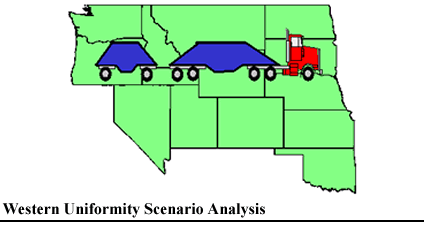
The Western Uniformity Scenario requested by the Western Governors' Association (WGA) from the Department of Transportation (DOT) is different than scenarios examined in the Comprehensive Truck Size and Weight (CTS&W) Study. Those scenarios focused on nationwide changes to truck size and weight limits. The Western Uniformity Scenario examines the impact of changes in truck size and weight regulations within a 13-State region in which all the States already allow at least some Longer Combination Vehicles (LCV). The States included in the analysis and shown in Figure II-1 are Colorado, Idaho, Kansas, Montana, Nebraska, Nevada, North Dakota, Oklahoma, Oregon, South Dakota, Utah, Washington and Wyoming.
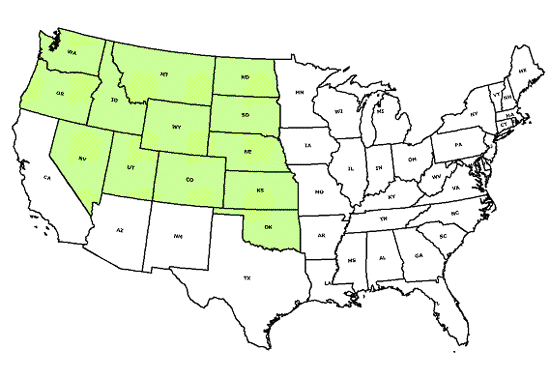
While all the States included in the scenario already allow LCVs, most do not allow the weights and dimensions analyzed in the Scenario. In discussions with State representatives during the course of this analysis, some said that even if given the flexibility to allow heavier weights they would not do so. Thus it must be remembered that, like the scenarios analyzed in the CTS&W Study, this scenario is only illustrative of the impacts that could occur if all the States in the region uniformly adopted the size and weight limits assumed in the scenario.
Several Western States currently do not allow LCVs including California, Texas, New Mexico, and Arizona (except for a very small corner of the State). These States were invited to join in the scenario analysis but all declined.
Figure II-2 shows the principal vehicle configurations examined in this analysis.
Figure II-2
Comparison of Longer Combination Vehicles with Conventional Trucks
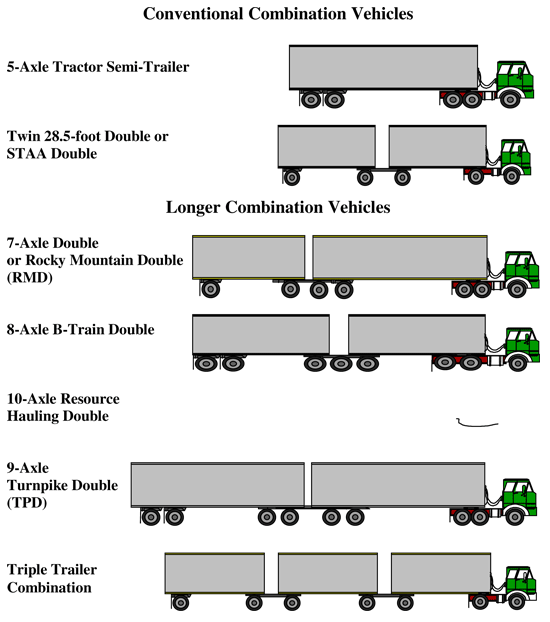
The analysis includes a broad range of commercial truck configurations: five- and six-or-more - axle tractor-semitrailers, several double-trailer combinations with different weights and dimensions, and triple-trailer combinations. All these configurations are present in both the base case and in the Scenario, although not all States allow all the scenario vehicles in the base case.
The impact analysis in this report focuses on the 13 States in the study region. Table II-1 shows their road networks as a percentage of the national networks. This table shows that these States contain a higher percent of rural roads than urban roads when compared to the whole U.S. Table II-2 shows that within the 13 States more than 80 percent of the public road system is classified as rural. 1
| Functional Class | 13 Analyzed States | Total US | Percent of Total |
|---|---|---|---|
| Rural Interstate | 8,598 | 33,048 | 26% |
| Rural Other Principal Arterial | 29,563 | 98,911 | 30% |
| Rural Minor Arterial | 32,788 | 137,574 | 24% |
| Rural Major Collector | 123,611 | 433,121 | 29% |
| Rural Minor Collector | 77,356 | 271,815 | 28% |
| Rural Local | 595,492 | 2,109,519 | 28% |
| Rural Total | 867,408 | 3,083,988 | 28% |
| Functional Class | 13 Analyzed States | Total US | Percent of Total |
|---|---|---|---|
| Urban Interstate | 1,591 | 13,379 | 12% |
| Urban Other Freeway and Expressways | 937 | 9,140 | 10% |
| Urban Other Principal Arterial | 5,945 | 53,312 | 11% |
| Urban Minor Arterial | 10,662 | 89,789 | 12% |
| Urban Collector | 10,155 | 88,200 | 12% |
| Urban Local | 68,964 | 598,421 | 12% |
| Urban Total | 98,254 | 852,241 | 12% |
| Total | 965,662 | 3,936,229 | 25% |
The analysis year for this scenario is 2010. Forecasts of traffic by commodity, origin and destination, vehicle configuration, weight, and highway functional class are based on current conditions including current truck size and weight limits. Global Insights, formerly DRI/WEFA, developed economic forecasts and traffic volumes were forecast based on those economic assumptions. Distributions of traffic by vehicle class, operating weight, and highway functional class were assumed to remain the same as estimates developed for 2000, the latest year for which actual traffic volume data are available.
| State | Rural | Urban | Total | Percent of Total | |||
|---|---|---|---|---|---|---|---|
| Interstate | Other | Interstate | Other | Rural | Urban | ||
| Colorado | 769 | 70,320 | 185 | 14,580 | 85,854 | 83% | 17% |
| Idaho | 526 | 41,590 | 85 | 4,110 | 46,311 | 91% | 9% |
| Kansas | 694 | 123,606 | 180 | 10,244 | 134,724 | 92% | 8% |
| Montana | 1,135 | 65,764 | 56 | 2,546 | 69,501 | 96% | 4% |
| Nebraska | 437 | 87,130 | 45 | 5,154 | 92,766 | 94% | 6% |
| Nevada | 480 | 32,513 | 80 | 5,585 | 38,658 | 85% | 15% |
| North Dakota | 531 | 84,226 | 41 | 1,793 | 86,591 | 98% | 2% |
| Oklahoma | 721 | 98,607 | 209 | 13,159 | 112,696 | 88% | 12% |
| Oregon | 581 | 55,040 | 146 | 11,019 | 66,786 | 83% | 17% |
| South Dakota | 629 | 80,827 | 49 | 2,057 | 83,562 | 97% | 3% |
| Utah | 771 | 33,659 | 167 | 7,610 | 42,207 | 82% | 18% |
| Washington | 501 | 62,293 | 263 | 17,929 | 80,986 | 78% | 22% |
| Wyoming | 826 | 24,000 | 87 | 2,379 | 27,292 | 91% | 9% |
Source: Highway Statistics Table HM-50.
The base case for the scenario represents current patterns of truck and rail operations in the scenario States under current truck size and weight laws. It serves as a base line for estimating impacts of changes in truck size and weight limits assumed in the scenario. The Federal size and weight limits for the base case are shown in Figure II-3.
The base case includes the freeze on LCVs imposed by the Intermodal Surface Transportation Efficiency Act of 1991 (ISTEA) that restricts the use of LCVs to the types of operations in effect as of June 1, 1991. The Transportation Equity Act for the 21st Century (TEA-21) continued the LCV freeze. It should be noted that there are two distinct freezes in the ISTEA, one on the weight of LCVs on the Interstate System and the other freeze on the length of the cargo carrying units of combinations with two or more such units on the NN. Table II-3 shows the lengths and weights of twin and triple trailer combinations that each of the 13 States included in the scenario may allow to operate under the LCV freeze.
Figure II-3
Base Case Federal Truck Size and Weight Limits
|
* The National Network (NN) is the system of highways designated by the States in cooperation with FHWA on which the 48-foot semitrailers and short twin trailer combinations that States were required to allow under the Surface Transportation Assistance Act of 1982 (STAA) would be allowed to operate. Those highways were judged by the States to be suitable for use by those truck configurations.
Several States allow heavier weights off the Interstate System than are allowed under the LCV freeze on the Interstate System (see Table II-6). For example, Wyoming allows up to 156,000 pounds on a double-trailer, with the appropriate number and spacing of axles, on State designated, non-Interstate roads, but the freeze limits GVW to 117,000 pounds on Wyoming Interstate. The appropriate weight limit is considered for each road segment in both the base case and the scenario analysis. It is also assumed that no change in technology, operating practices, or relative pricing will take place between the base year (2000) and the analysis year (2010). Finally it is assumed that there would be no change in the TS&W regulations and VMT for any States other than those in the study.
| State | Truck Tractor and Two Trailing Units |
Truck Tractor and Three Trailing Units |
Other2 | ||
|---|---|---|---|---|---|
| Length | Weight | Length | Weight | Length | |
| Colorado | 111' |
110K |
115.5' |
110K |
78' |
| Idaho | 95' |
105.5K |
95' |
105.5K |
78' - 98' |
| Kansas | 109' |
120K |
109' |
120K |
No |
| Montana | 93' |
137.8K |
100' |
131.06K |
88' - 103' |
| Nebraska | 95' |
95K |
95' |
(1) |
68' |
| Nevada | 95' |
129K |
95' |
129K |
98' |
| North Dakota | 103' |
105.5K |
100' |
105.5K |
103' |
| Oklahoma | 110' |
90K |
95' |
90K |
No |
| Oregon | 68' |
105.5K |
96' |
105.5K |
70'5” |
| South Dakota | 100' |
129K |
100' |
129K |
73' - 78' |
| Utah | 95' |
129K |
95' |
129K |
88' - 105' |
| Washington | 68' |
105.5K |
No |
68' |
|
| Wyoming | 81' |
117K |
No |
78' - 85' |
|
(1) No maximum weight is established as this vehicle combination is not considered an “LCV” per the ISTEA definition because it is only allowed up to 80,000 pounds.
(2) A commercial motor vehicle combination with two or more cargo-carrying units not included in descriptions “truck tractor and two trailer units” or “truck tractor and three trailer units.”
Source: Federal Size Regulations for Commercial Motor Vehicles, FHWA Publication Number FHWA-MC-96-03, for details on specific vehicle combinations see 23 CFR 658, Appendix C
Analytical Improvements
Changes since the CTS&W Study include (1) updating the truck and rail commodity flow data and the distribution of truck traffic by configuration, highway functional class, and operating weight; (2) a detailed analysis of LCV operations in Western States; and (3) detailed analysis of the road networks on which LCVs currently are allowed.
The base year for the CTS&W Study was 1994 with a forecast year of 2000. For the Western Uniformity Scenario, base year vehicle miles traveled (VMT) was updated to 2000 using the 2000 Highway Performance Monitoring System (HPMS) data. The HPMS data were augmented by State truck weight data to estimate VMT by configuration, highway functional class, and operating weight, following the same methodology as was used in the 1997 Highway Cost Allocation Study. Table II-4 summarizes the VMT by configuration for the 13 States in the present analysis.
The truck commodity flow database is significantly improved compared with that which was available for the CTS&W Study. In the CTS&W Study the truck flow data was based on a national survey of 24,000 truck drivers, but could not be calibrated to national totals and the relevant sample for a regional analysis was very small.
The truck commodity flow data for the scenario analysis is now based on the Freight Analytical Framework (FAF) developed by FHWA.2 The FAF truck data was created from a synthesis of the 1994 Commodity Flow Survey, 5-year Census and Annual Survey of Manufacturers, county population data, Motor Carrier Industry Financial & Operating Statistics, trade association production and shipment reports, and private data sources. The FAF truck database is calibrated to national totals3 and is geographically specific. County-to-county flows of nearly 400 different commodities groups are estimated.4 The database of both private and for-hire trucking comes close to capturing the universe of truck shipments and can be broken apart into regional and State subsets.
The rail shipment database was also updated using the 2000 Rail Waybill. This is an improvement over the 1994 data used in the CTS&W Study since this data reflects rail traffic flows following the round of rail mergers in the mid and late 90's.
Global Insight, a nationally recognized economic forecasting company, (formerly DRI/WEFA) developed the 2010 forecasts of commodity flows using demand-based forecasting to estimate the consumption growth from which truck and rail commodity flows are derived. Table II-5 summarizes forecasts of domestic tons to be hauled by trucks and railroads.
Only those trucks likely to be impacted by changes in TS&W limits were explicitly modeled in the analysis. Figure II-4 shows the commercial vehicles included in the analysis and characteristics of how those vehicles are currently used in the Western States. Changes to their operations under the Western Uniformity Scenario are discussed in Chapter III. Specifically the turnpike double would become utilized for more general freight shipments.
Single unit trucks are not included in this analysis since the scenario hypothesizes no changes to their weights or operating conditions and operators are unlikely to switch from single unit trucks to combination trucks.
| State | Single Unit Truck | Tractor Semi-trailer with 3 to 4 axles | Tractor Semitrailer with 5 axles | Tractor Semi-trailer with 6 or more axles | Truck Trailer with 3 to 4 axles | Truck Trailer with 5 axles | Truck Trailer with 6 or more axles | Double trailer with 5 or 6 axles | Double trailer with 7 axles | Double trailer with 8 axles or more axles | Triple Trailer | |||||||||||
|---|---|---|---|---|---|---|---|---|---|---|---|---|---|---|---|---|---|---|---|---|---|---|
| Year | 2000 | 2010 | 2000 | 2010 | 2000 | 2010 | 2000 | 2010 | 2000 | 2010 | 2000 | 2010 | 2000 | 2010 | 2000 | 2010 | 2000 | 2010 | 2000 | 2010 | 2000 | 2010 |
| Colorado | 1,263 | 1,716 | 155 | 209 | 1,096 | 1,452 | 82 | 112 | 16 | 21 | 27 | 37 | 6 | 8 | 37 | 50 | 21 | 28 | 3 | 5 | 2 | 2 |
| Idaho | 341 | 453 | 49 | 66 | 482 | 635 | 110 | 147 | 2 | 2 | 14 | 19 | 26 | 37 | 30 | 39 | 22 | 30 | 7 | 10 | 7 | 10 |
| Kansas | 933 | 985 | 126 | 138 | 1,151 | 1,280 | 132 | 144 | 11 | 13 | 11 | 13 | 22 | 27 | 47 | 54 | 3 | 4 | 1 | 1 | 1 | 1 |
| Montana | 240 | 255 | 28 | 30 | 396 | 422 | 95 | 104 | 6 | 7 | 9 | 10 | 45 | 53 | 41 | 45 | 14 | 15 | 11 | 13 | 0 | 0 |
| Nebraska | 454 | 300 | 126 | 76 | 2,051 | 318 | 97 | 133 | 6 | 8 | 3 | 8 | 21 | 40 | 9 | 14 | - | - | - | - | 1 | 0 |
| Nevada | 520 | 429 | 79 | 119 | 656 | 1,954 | 31 | 92 | 0 | 6 | 40 | 3 | 30 | 21 | 32 | 9 | 20 | - | 4 | - | 2 | 1 |
| North Dakota | 265 | 646 | 65 | 107 | 272 | 887 | 115 | 42 | 7 | 0 | 6 | 55 | 32 | 43 | 12 | 43 | - | 27 | - | 6 | 0 | 3 |
| Oklahoma | 1,410 | 1,710 | 389 | 467 | 2,639 | 3,153 | 169 | 203 | 21 | 25 | 28 | 35 | 3 | 4 | 54 | 65 | 1 | 2 | - | - | 1 | 1 |
| Oregon | 1,044 | 1,176 | 234 | 260 | 1,078 | 1,217 | 291 | 327 | 0 | 0 | 21 | 24 | 29 | 34 | 705 | 820 | 12 | 14 | 35 | 42 | 22 | 26 |
| South Dakota | 262 | 282 | 36 | 39 | 389 | 417 | 77 | 83 | 4 | 4 | 5 | 5 | 16 | 19 | 19 | 20 | 10 | 11 | 21 | 25 | 0 | 0 |
| Utah | 482 | 651 | 89 | 121 | 753 | 991 | 65 | 87 | 6 | 8 | 20 | 28 | 92 | 132 | 49 | 66 | 25 | 33 | 13 | 19 | 1 | 2 |
| Washington | 1,510 | 1,472 | 120 | 116 | 856 | 829 | 385 | 383 | 18 | 18 | 73 | 74 | 145 | 152 | 72 | 71 | 22 | 21 | 81 | 84 | - | - |
| Wyoming | 149 | 166 | 62 | 73 | 731 | 921 | 56 | 65 | 6 | 8 | 22 | 30 | 44 | 57 | 40 | 54 | 3 | 4 | 6 | 8 | - | - |
| Total | 8,873 | 10,240 | 1,558 | 1,821 | 12,551 | 14,476 | 1,706 | 1,924 | 102 | 120 | 279 | 341 | 511 | 626 | 1,147 | 1,351 | 154 | 188 | 183 | 213 | 37 | 45 |
| Percent of Fleet | 31.8% | 32.7% | 5.6% | 5.8% | 45.0% | 46.2% | 6.1% | 6.1% | 0.4% | 0.4% | 1.0% | 1.1% | 1.8% | 2.0% | 4.1% | 4.3% | 0.6% | 0.6% | 0.7% | 0.7% | 0.1% | 0.1% |
| Mode | 1998 | 2010 |
|---|---|---|
| Air | 9 | 18 |
| Highway | 10,439 | 14,929 |
| Rail | 1,953 | 2,527 |
| Water | 1,082 | 1,344 |
| Grand Total | 13,484 | 18,820 |
*Source: Freight Analytical Framework, FHWA
| Configuration Type | Number of Axles | Common Maximum Weight (pounds) | Current Use |
|---|---|---|---|
| Semitrailer | 5 | 80,000 - 99,000 | Most used combination vehicle. It is used for long and short hauls in all urban and rural areas to carry and distribute all types of materials, commodities, and goods |
| 6 or more | 80,000 - 100,000 | Used to haul heavier materials, commodities, and goods for hauls longer than those of the four-axle single-unit truck. | |
| STAA Double | 5, 6 | 80,000 | Most common multi-trailer combination. Used for less-than-truckload (LTL) freight mostly on rural freeways between LTL terminals. |
| B-train Double | 8 | 105,500 - 137,800 | Mostly used in flatbed trailer operations and for liquid bulk hauls |
| Rocky Mountain Double (RMD) | 7 | 105,500 - 129,000 | In the Western States used as a resource hauling vehicle, usually open hopper, tank, or flat. |
| Turnpike Double (TPD) | 9 | 105,500 - 147,000 | Some truckload operations similar to a 5 or 6 axle Semitrailer but mostly a western State resource-hauling vehicle. |
| Triple Trailer Combination | 7 | 90,000 - 129,000 | Similar to an STAA Double, used for less-than-truckload (LTL) freight mostly on rural freeways between LTL terminals. |
The truck configurations analyzed in this study conform to the State and Federal regulations and current operations. All of the 13 States analyzed allow variations from Federal truck size and weight limits, but all5 utilize the Federal Bridge Formula B to control loads placed on bridges. The formula gives the allowable weight on any group of two or more axles in terms of the number and spacing of the axles,
W=500[LN/(N-1) + 12N +36]
Where
W = allowable weight on the collection of axles under consideration
L = length between extreme axles in collection of axles under consideration
N = number of axles under consideration
In most States (10 out of 13), the Bridge Formula is capped at a fixed value tied to that State's grandfather rights. The States that don't have a fixed cap use the bridge formula as their practical limit. Table II-6 lists the LCV length and gross vehicle weight (GVW) limit for the States analyzed in this study. Figures II-5 and II-6 show the geographical significance of the GVW and length variations on Interstate transportation.
Some States regulate the overall length of the vehicle from front to rear bumper, other States regulate the combined length of the trailers, and still others regulate the length of the individual trailers.
Interviews with shippers provided useful insight into impacts on Interstate operations where no two States have the same truck size and weight limits. Often shippers must study each State's regulations and then design a vehicle to match the State with the most restrictive truck size and weight rules to avoid costly re-configuration at the borders. This sometimes precludes an out-of-state truck operator from bidding on a job since in-state operators already own the most economically efficient configurations.
The wide variety of size and weight rules in the Western States has given rise to uniquely-designed, jurisdictionally-specific vehicles. Figure II-7 provides examples of specific vehicles designed for the unique jurisdictional rules in the Western States. In Figure II-7 the “Montana Truck 2 Sugar Beets GVW 123,000,” with 9-axles, 81-feet combined trailer length and a tare weight of 38,100 has a competitive disadvantage in Washington, Idaho or Oregon since resource haulers in those States employ a truck with 7-axles, 68-foot combined trailer length and a lower tare weight of 34,300 pounds (see Figure II-7, "Washington/Idaho/Oregon GVW 105,500"). The heavier tare weight of the Montana truck, due to additional axles and trailer length, translates into a lower payload given Washington, Idaho and Oregon's maximum GVW of 105,500 pounds and higher cost per payload ton mile.
| STATE | DOUBLES MAXIMUM LENGTH (FEET) | DOUBLES MAXIMUM GROSS VEHICLE WEIGHT (POUNDS) | TRIPLES MAXIMUM LENGTH PER TRAILER(FEET) | TRIPLES MAXIMUM GROSS VEHICLE WEIGHT (POUNDS) | |
|---|---|---|---|---|---|
| Rocky Mountain Double | Turnpike Double | ||||
| Colorado5 | 48 + 28.5 | 48 + 48 | 110,000 | 28.5 each | 110,000 |
| Idaho | 105 overall | 105 overall | 105,500 | 28.5 each | 105,500 |
| Kansas | 48 + 28.5 | 48 + 48 | 120,000 | 28.5 each | 120,000 |
| Montana | 95 overall or 81 CTL3 | 95 overall or 81 CTL3 | Uncapped BFB2 | 95' overall | Uncapped BFB2 |
| North Dakota | 110 overall | 110 overall | 105,500 | 110' overall | 105,500 |
| Nebraska | 105 CTL3 | 105 CTL3 | 95,000 | 28.5 each | empty |
| Nevada | 105 CTL3 up to 48 + 42 | 105 CTL3 up to 48 + 42 | 129,000 | 28.5 each | 129,0004 |
| Oklahoma | 110 CTL3 up to 53 + 53 | 110 CTL3 up to 53 + 53 | 90,000 | 29 each, up to 95' CTL3 | 90,000 |
| Oregon5 | 68 CTL340 + 20 | Not allowed | 105,500 | 28.5 each, up to 96' CTL3 | 105,500 |
| South Dakota | 110 CTL3 | 110 CTL3 | 129,000 | 28.5 each | 129,0004 |
| Utah | 95' CTL3 | 95' CTL3 | 129,000 | 95' CTL3 | 129,0004 |
| Washington | 68 CTL3 | Not allowed | 105,500 | Not allowed | Not allowed |
| Wyoming | 81 CTL3 | 81 CTL3 | 117,000 (Interstate), Uncapped BFB2 (off-interstate) | Not allowed | Not allowed |
The scenario impacts are evaluated based on assumptions concerning the networks that would be available for various types of LCVs. Several networks are considered in the analysis -- the National Network (NN) for large trucks designated pursuant to the STAA of 1982; networks on which the three general types of LCVs (RMD, TPD, and Triples) currently are allowed to operate; and the networks assumed in the scenario to be available for each type of LCV. Under the scenario, routes currently available for LCVs in particular States are assumed to remain available to those vehicles, even if they are beyond the networks assumed in the scenario to be available to particular configurations.
County-to-county mileages were developed for all 7 networks using the National Highway Planning Network (NHPN)6 and the 3 current and 3 scenario LCV networks. The NHPN is a comprehensive network database geographically coding for over 400,000 roadway miles including Rural Arterials, Urban Principal Arterials, and all the National Highway System routes. The NHPN is used as a surrogate for the NN since most 53-foot tractor semi-trailers and STAA Doubles have broad access in the analyzed States.
The use of specific highway networks allows the proposed changes in the truck size and weight limits to be measured on specific highway functional classes within each State. For each network, the mileage to and from each county population center was determined. For each origin-destination pair the following information was derived: (1) travel distance based on shortest travel time; (2) estimated travel time; (3) mileage on each highway functional class; and (4) non-network miles between origin/destination to the road network (i.e. drayage distance).
The network routings attempted to include all roads with current operations, but some additional restrictions were beyond the modeling capabilities, including "time of day" restrictions (for example, LCVs are not allowed in Denver, Colorado during rush hour) or "day of the week" restrictions (for example, no LCVs are allowed on Oregon's coastal roads on the weekends).
Combinations with 48-foot semitrailers and "STAA" double trailers operate on a 200,000-mile network designated under the Surface Transportation Assistance Act of 1982 (STAA). Combinations with semi-trailers longer than 48 feet generally must comply with State routing requirements and provisions to minimize vehicle off-tracking. Figure II-8 shows the current permit requirements and route restrictions for LCVs in each scenario State.
Figure II-5
Current LCV Gross Vehicle Weights
(pounds)
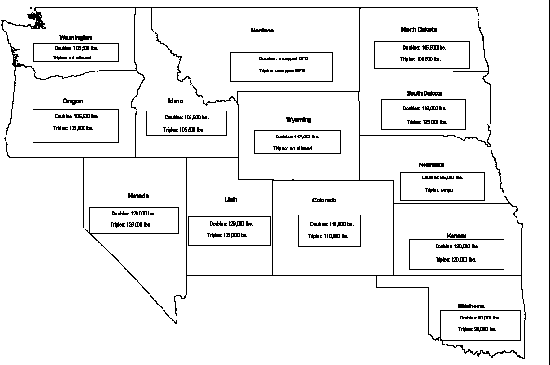
Notes: RMD is Rocky Mountain Double, TPD is Turnpike Double and BFB is Bridge Formula B
Figure II-6
Current LCV Lengths
(feet)
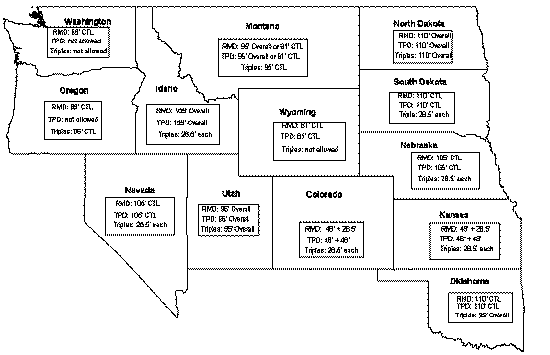
Notes: RMD is Rocky Mountain Double, TPD is Turnpike Double and CTL is Combined Trailer Length
Figure II-7
Vehicles Operating in the Western Study States
(feet)
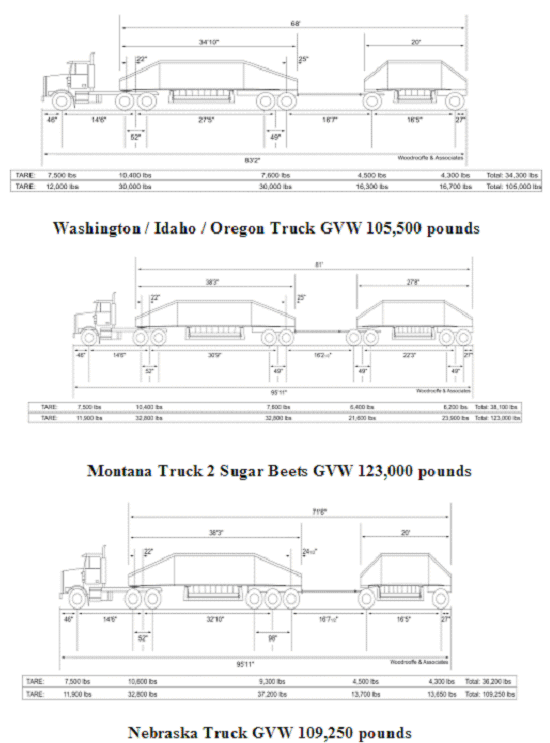
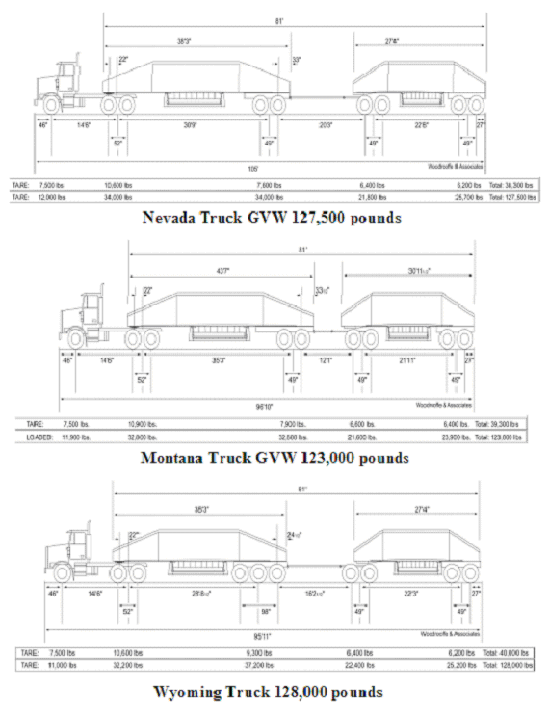
| State | Permit Required | Route Restrictions |
|---|---|---|
| Colorado | Annual permit required | Restricted to designated Interstate and state highway segments |
| Idaho | Required; good for 1 year from date of issuance | Allowed on National Network (NN) routes and access routes to breakdown areas via interchanges designated for LCVs |
| Kansas | Access permits, valid for 6 months required for access between Kansas Turnpike & terminals located within a 10-mile radius of each tollbooth except at NE end of Turnpike where 20-mile radius allowed. Special Vehicle Combination (SVC) permits, good for 1 year, are required for operation on I-70 between Colorado state line and Exit 19 | Allowed only on Kansas Turnpike, Special Vehicle Combination (SVC) triples allowed only on I-70 from Colorado state line to Exit 19 |
| Montana | Required for double trailer combinations if either trailer exceeds 28.5'. Annual or trip permits available; require continuous travel. Special triple vehicle annual or single trip permit required | Allowed on NN routes except US 87 from milepost 79.3 to milepost 82.5. Doubles have length and access limits. Triples allowed only on Interstate System and granted a 2-mile access off Interstate System for loading or service |
| North Dakota | Required if combination has gross vehicle weight of 80,000 pounds or more | Allowed on all NN routes with 10-mile access from National Network |
| Nebraska | Annual length permit required for cargo-carrying combinations greater than 65' | Triples can only travel empty. LCVs allowed on I-80 from Wyoming state line to Exit 440 (NE50); only doubles allowed a 6-mile access to designated staging areas |
| Nevada | Required | Allowed on all NN routes except US 93 from NV 500 to Arizona state line |
| Oklahoma | Required for all combinations | Allowed on NN and legally-available routes. 5-mile access from legal routes |
| Oregon | Permit required if gross vehicle weight is 80,000 pounds or more | Oregon Doubles allowed on all NN routes. Triples allowed only on routes approved by Oregon DOT. Access determined by Oregon DOT |
| South Dakota | Required if combination has gross vehicle weight of 80,000 pounds or more | Doubles with cargo-carrying length of 81.5 feet or less are allowed on all NN routes with statewide access unless restricted by South Dakota DOT. Doubles over 81.5 feet and triples are allowed on the Interstate System and selected state routes. Access must be approved by South Dakota DOT |
| Utah | Required | All NN routes with access routes approved by Utah DOT for combinations of less than 85'. Combinations 85' and over may operate only on NN routes: I-15, I70 from JCT. I15 to Colorado state line, I-80, I-84 from JCT. I80 to Idaho state line, I-215, and UT 201 from I80 Exit 102 to 300 West St. Salt Lake City |
| Washington | Required for cargo-carrying units over 60' but not exceeding 68' | Allowed on all NN and state routes except WA 410 and WA 123 in Mt. Rainier N.P. May be restricted by local ordinances |
| Wyoming | No | Allowed on all NN routes and unlimited access off NN to terminals |
As part of the study's outreach effort, extensive routing maps were created showing the truck size and weight regulations in each State. Figures II-9 through II-11 show the current networks available for RMD (maximum 68-feet combined trailer length), TPD (82-feet combined trailer length and up) and triple trailer combinations. Most States do not prescribe a difference between Rocky Mountain Doubles and Turnpike Doubles; they specify routes for different combined trailer lengths. The distinction between Rocky Mountain Doubles and Turnpike Doubles is made in the maps below to facilitate comparisons in the Western Uniformity Scenario. In general a RMD has a combined trailer length between 68 and 81 feet and a TPD has a combined trailer length between 82 and 101 feet.
Figure II-9
Rocky Mountain Doubles Base Case Network
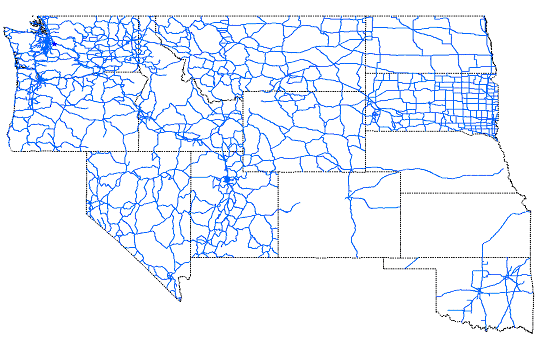
Figure II-10
Turnpike Doubles Base Case Network
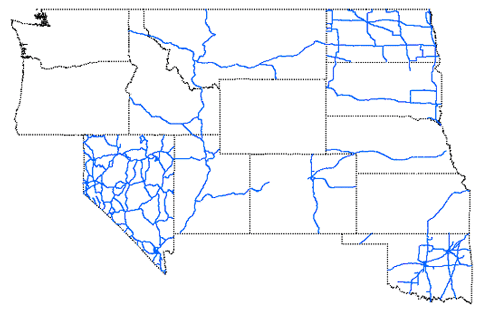
Figure II-11
Triples Base Case Network
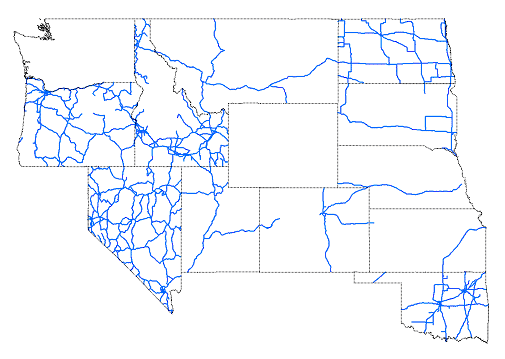
The LCV freeze imposed by the ISTEA of 1991 responded to public concerns regarding the safety of LCVs as well as concerns regarding rail competitiveness. This freeze prevents the States from changing the weights, lengths, and routes of LCVs. For purposes of the freeze, LCVs are defined as commercial motor vehicles having two or more cargo units and gross weights above 80,000 pounds. Figure II-12 provides additional details on the LCV freeze.
The Western Uniformity Scenario explores the impact of lifting the LCV freeze for 13 Western States and allowing States to set weight limits for LCVs that would be controlled only by federal axle load limits and the Federal Bridge Formula. Trailer lengths would be limited to 48 feet for twin trailer combinations and 28.5 feet for triple trailer combinations. Operations would generally conform to the Guide for Uniform Laws and Regulations Governing Truck Size and Weight Among the WASHTO States (January, 2000) that was adopted by the Western Association of State Highway and Transportation Officials (WASHTO).
Several States belonging to WASHTO chose not to participate in the analysis - Arizona, California, New Mexico, and Texas.7 The non-participating States do not currently have LCV operations. As noted above, a number of States included in the analysis indicated they would not adopt the size and weight limits assumed in the scenario, even if given the flexibility to do so. Thus, like the other CTS&W Study Scenarios, this scenario is merely illustrative of the impacts that might occur if assumptions in the scenario were fully implemented.
| The Intermodal Surface Transportation Efficiency Act (ISTEA) of 1991 imposed a freeze on States to restrict the operation of Longer Combination Vehicles (LCVs) on the Interstate System to the type of vehicles in use on or before June 1, 1991. The ISTEA defined an LCV as a combination of a tractor and two or more trailing units weighing more than 80,000 pounds that operates on the Interstate. This freeze was continued with the Transportation Equity Act for the 21st Century. |
| In addition to freezing the weights, lengths and routes of LCVs on the Interstate System, ISTEA froze the lengths and routes of commercial motor vehicles having two or more cargo units on the National Network for Large Trucks. A commercial motor vehicle is a motor vehicle designed or regularly used for carrying freight whether loaded or empty. |
| Because of the freeze, States that did not allow LCV operations prior to June 1, 1991 are precluded from allowing them. States that did allow LCVs are precluded from lifting restrictions that governed LCV operations as of that date. Such restrictions may include route-, vehicle- and driver- specific requirements. |
The Western Uniformity Scenario estimates the impact of lifting the LCV freeze (see Figure II 1) for 13 contiguous States: Colorado, Idaho, Kansas, Montana, Nebraska, Nevada, North Dakota, Oklahoma, Oregon, South Dakota, Utah, Washington and Wyoming. These States would be allowed to increase the size and weights of their LCVs to match the WASHTO guidelines. Four of the participating States, Montana, Nevada, South Dakota and Utah would experience little change since they currently operate vehicles at, or above, the scenario limits. The scenario assumes that all States would uniformly adopt the new limits, and therefore captures the maximum impact.
The Vehicles
The scenario focuses on three LCVs, Rocky Mountain Doubles (RMD), Turnpike Doubles (TPD) and Triple-Trailer Combinations (Triples). All lengths and weights are subject ot the BFB limits. All the participating States currently allow RMDs, although combined trailer length limits vary from 68- to 81-feet and weight limits vary from 105,500 to 129,000 pounds. A typical RMD consists of a three-axle truck-tractor with a long front trailer (40- to 48-foot) and a shorter (20- to 28.5-foot) rear trailer. RMDs are used for general freight and resource hauls. The scenario assumes that all 13 States would allow RMDs a combined trailer length of 81-feet and a GVW of 129,000 pounds. The trailers would be allowed up to a 48-foot lead trailer with a 28.5-foot rear trailer.
The scenario also includes the triple-trailer combination. A typical triple consists of a two- or three-axle truck-tractor towing three trailers. Each trailer is usually 28- to 28.5-feet in length. Of the 13 States in the study, only Washington and Wyoming do not currently allow triples. Nebraska allows only empty triples on a very limited network.8 Triples are mostly utilized by the less-than-truckload industry to move relatively small shipments among their terminal network. The scenario would allow triples to operate up to three 28.5-foot trailers with a GVW of 110,000 pounds.
The longest and heaviest configuration tested in the scenario is the Turnpike Double (TPD). It would be allowed to 129,000 pounds GVW and have either maximum twin 48-foot trailers (101 feet combined trailer length) or maximum twin 45-foot trailers (95 feet combined trailer length). Both cases are tested since the WASHTO guide recommends twin 45-foot trailers, but five of the participating States currently allow the longer TPD, and 48-foot trailers are more common in the general truck fleet.9 For discussion purposes this breaks the scenario into two cases: (1) the High-Cube Case that includes the twin 48-foot trailers; and (2) the Low-Cube Case that includes the twin 45-foot trailers. Both the High- and Low-Cube Cases include the RMD up to 81-feet combined trailer length and the triple-trailer configurations.
Figure II-13 summarizes the main features of the Western Uniformity Scenario.
Figure II-13
Western Uniformity Scenario
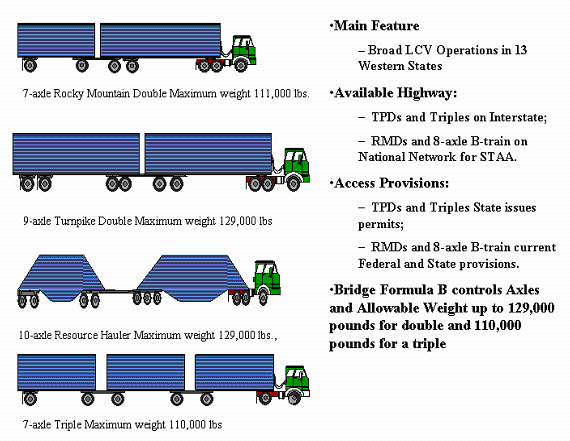
The Networks
Highway networks on which various LCVs were assumed to operate under the scenario are as follows: (1) RMDs would be allowed on the NN System and (2) TPDs and triples would be allowed only on the Interstate Highway System. As in the CTS&W Study, a larger network is assumed for RMDs because of their superior ability to negotiate curves and grades. The scenario networks are shown in Figures II 14 through II-16. In creating the scenario networks, it was assumed that States would continue to allow LCVs on all the current routes where LCVs now operate.
Figure II-14
Rocky Mountain Double Western Uniformity Scenario Network
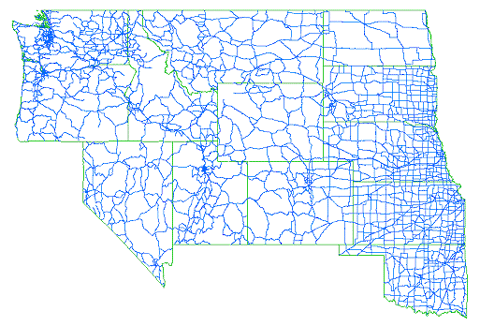
Figure II-15
Turnpike Doubles Western Uniformity Scenario Network
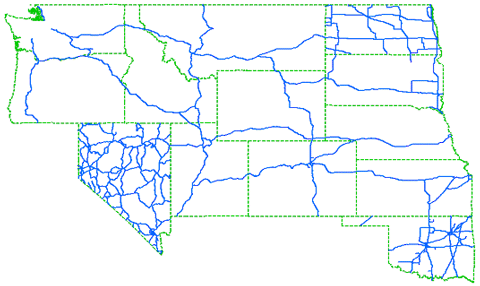
Figure II-16
Triples Western Uniformity Scenario Network
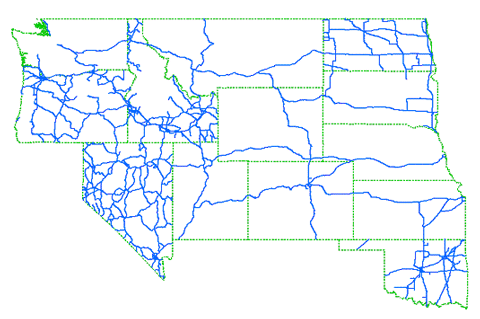
Access Provisions
Current rules in the Western States control access to and from the road networks, see Figure II-8. The scenario assumes that States would continue to control access to and from the networks to mitigate LCV impacts on bridges, pavement, roadway geometry and congestion.
Because of poor off-tracking, or cornering, performance, the scenario assumes that TPDs would be restricted to the designated TPDs network. It is assumed that drivers of these vehicles will use staging areas—large parking lots—to disconnect the extra trailer and attach that trailer to another tractor for delivery to its final destination. Drayage is assumed to be along the most direct route off the network between the shipper or receiver and the network.
Triple-trailer combinations are allowed direct access, under a State-issued permit, to and from the network without disconnecting the trailers for up to 2 miles for loading or service.